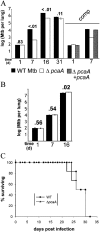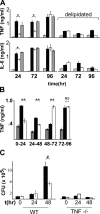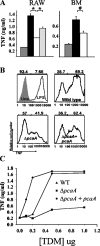Mycobacterium tuberculosis controls host innate immune activation through cyclopropane modification of a glycolipid effector molecule
- PMID: 15710652
- PMCID: PMC2213067
- DOI: 10.1084/jem.20041668
Mycobacterium tuberculosis controls host innate immune activation through cyclopropane modification of a glycolipid effector molecule
Abstract
Mycobacterium tuberculosis (Mtb) infection remains a global health crisis. Recent genetic evidence implicates specific cell envelope lipids in Mtb pathogenesis, but it is unclear whether these cell envelope compounds affect pathogenesis through a structural role in the cell wall or as pathogenesis effectors that interact directly with host cells. Here we show that cyclopropane modification of the Mtb cell envelope glycolipid trehalose dimycolate (TDM) is critical for Mtb growth during the first week of infection in mice. In addition, TDM modification by the cyclopropane synthase pcaA was both necessary and sufficient for proinflammatory activation of macrophages during early infection. Purified TDM isolated from a cyclopropane-deficient pcaA mutant was hypoinflammatory for macrophages and induced less severe granulomatous inflammation in mice, demonstrating that the fine structure of this glycolipid was critical to its proinflammatory activity. These results established the fine structure of lipids contained in the Mtb cell envelope as direct effectors of pathogenesis and identified temporal control of host immune activation through cyclopropane modification of TDM as a critical pathogenic strategy of Mtb.
Figures






Similar articles
-
Trans-cyclopropanation of mycolic acids on trehalose dimycolate suppresses Mycobacterium tuberculosis -induced inflammation and virulence.J Clin Invest. 2006 Jun;116(6):1660-7. doi: 10.1172/JCI27335. J Clin Invest. 2006. PMID: 16741578 Free PMC article.
-
A role for tumour necrosis factor-alpha, complement C5 and interleukin-6 in the initiation and development of the mycobacterial cord factor trehalose 6,6'-dimycolate induced granulomatous response.Microbiology (Reading). 2008 Jun;154(Pt 6):1813-1824. doi: 10.1099/mic.0.2008/016923-0. Microbiology (Reading). 2008. PMID: 18524936 Free PMC article.
-
A mycobacteriophage-derived trehalose-6,6'-dimycolate-binding peptide containing both antimycobacterial and anti-inflammatory abilities.FASEB J. 2013 Aug;27(8):3067-77. doi: 10.1096/fj.13-227454. Epub 2013 Apr 19. FASEB J. 2013. PMID: 23603838
-
The inflammatory response in Mycobacterium tuberculosis infection.Arch Immunol Ther Exp (Warsz). 2000;48(6):513-9. Arch Immunol Ther Exp (Warsz). 2000. PMID: 11197606 Review.
-
Cord factor as an invisibility cloak? A hypothesis for asymptomatic TB persistence.Tuberculosis (Edinb). 2016 Dec;101S:S2-S8. doi: 10.1016/j.tube.2016.09.023. Epub 2016 Sep 28. Tuberculosis (Edinb). 2016. PMID: 27743706 Review.
Cited by
-
The current state of animal models and genomic approaches towards identifying and validating molecular determinants of Mycobacterium tuberculosis infection and tuberculosis disease.Pathog Dis. 2019 Jun 1;77(4):ftz037. doi: 10.1093/femspd/ftz037. Pathog Dis. 2019. PMID: 31381766 Free PMC article. Review.
-
A Phenotypic Characterization of Two Isolates of a Multidrug-Resistant Outbreak Strain of Mycobacterium tuberculosis with Opposite Epidemiological Fitness.Biomed Res Int. 2020 Apr 8;2020:4741237. doi: 10.1155/2020/4741237. eCollection 2020. Biomed Res Int. 2020. PMID: 32337252 Free PMC article.
-
Mycolic acid cyclopropanation is essential for viability, drug resistance, and cell wall integrity of Mycobacterium tuberculosis.Chem Biol. 2009 May 29;16(5):499-509. doi: 10.1016/j.chembiol.2009.04.001. Chem Biol. 2009. PMID: 19477414 Free PMC article.
-
MadR mediates acyl CoA-dependent regulation of mycolic acid desaturation in mycobacteria.Proc Natl Acad Sci U S A. 2022 Feb 22;119(8):e2111059119. doi: 10.1073/pnas.2111059119. Proc Natl Acad Sci U S A. 2022. PMID: 35165190 Free PMC article.
-
Temperature-dependent regulation of mycolic acid cyclopropanation in saprophytic mycobacteria: role of the Mycobacterium smegmatis 1351 gene (MSMEG_1351) in CIS-cyclopropanation of alpha-mycolates.J Biol Chem. 2010 Jul 9;285(28):21698-707. doi: 10.1074/jbc.M110.125724. Epub 2010 May 10. J Biol Chem. 2010. PMID: 20457615 Free PMC article.
References
-
- Cosma, C.L., D.R. Sherman, and L. Ramakrishnan. 2003. The secret lives of the pathogenic mycobacteria. Annu. Rev. Microbiol. 57:641–676. - PubMed
-
- Clark-Curtiss, J.E., and S.E. Haydel. 2003. Molecular genetics of Mycobacterium tuberculosis pathogenesis. Annu. Rev. Microbiol. 57:517–549. - PubMed
-
- Cox, J.S., B. Chen, M. McNeil, and W.R. Jacobs Jr. 1999. Complex lipid determines tissue-specific replication of Mycobacterium tuberculosis in mice. Nature. 402:79–83. - PubMed
-
- Camacho, L.R., D. Ensergueix, E. Perez, B. Gicquel, and C. Guilhot. 1999. Identification of a virulence gene cluster of Mycobacterium tuberculosis by signature-tagged transposon mutagenesis. Mol. Microbiol. 34:257–267. - PubMed
Publication types
MeSH terms
Substances
Grants and funding
LinkOut - more resources
Full Text Sources
Other Literature Sources
Molecular Biology Databases

